Homo species - Study guides, Class notes & Summaries
Looking for the best study guides, study notes and summaries about Homo species? On this page you'll find 548 study documents about Homo species.
Page 4 out of 548 results
Sort by

-
Life 103 Final Exam CSU (exam 1-3) Graded A Q&A Complete
- Exam (elaborations) • 15 pages • 2024
- Available in package deal
-
- $7.99
- + learn more
Phylogeny - Classification of organisms according to evolutionary relationships. Taxonomy - Evolutionary classification Linnaean system of classification (taxonomy) - Domain> Kingdom> Phylum> Class> Order> Family> Genus> Species (Did King Phillip Come Over For Grandma's Soup) [ex. Homo sapien](italicized) Phylogeny relationships - Basal Group: Branch from oldest common ancestor, no other branch from species. Sister Taxa: Share common ancestor Homologies - Comparing...

-
BIOL 121 EXAM 1 PURDUE 77 |Review | Questions with 100% Correct Answers | Verified | Latest Update
- Exam (elaborations) • 15 pages • 2024
- Available in package deal
-
- $7.99
- + learn more
Prokaryote - ️️unicellular single membrane bacteria and archaea Eukaryote - ️️inner & outer membrane organelles un cells -nucleus: genetic material -mitochondria: power house Homo sapiens - ️️homo - genus sapins - name of species Carbohydrates - ️️starches and sugars Carbohydrate function - ️️source of energy stored energy structural components Monosaccharides - ️️ribose, glucose, glyceraldehyde simple sugars Disaccharide - ️️double sugar s...
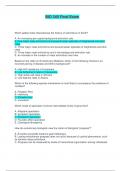
-
BIO 345 Final Exam | Questions and Answers (Complete Solutions)
- Exam (elaborations) • 18 pages • 2024
-
- $19.99
- + learn more
BIO 345 Final Exam | Questions and Answers (Complete Solutions) Which pattern best characterizes the history of extinctions on Earth? A. An increasing per capita background extinction rate B. Five major mass extinctions and several lesser episodes of heightened extinction rates C. Three major mass extinctions and several lesser episodes of heightened extinction rates D. Three major mass extinctions and a low background extinction rate E. An increase in the number of mass extinctions over time...
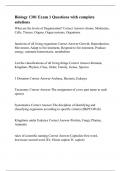
-
Biology 1301 Exam 1 Questions with complete solutions
- Exam (elaborations) • 6 pages • 2024
-
- $14.99
- + learn more
What are the levels of Organization? Correct Answer-Atoms, Molecules, Cells, Tissues, Organs, Organ systems, Organisms functions of all living organisms Correct Answer-Growth, Reproduction, Movement, Adapt to Environment, Respond to Environment, Produce energy, maintain homeostasis, metabolism List the classifications of all living things Correct Answer-Domain, Kingdom, Phylum, Class, Order, Family, Genus, Species 3 Domains Correct Answer-Archaea, Bacteria, Eukarya Taxonomy Correct A...

-
Biology 1406 Exam 1 study material latest update graded A+
- Exam (elaborations) • 10 pages • 2024
-
- $9.99
- + learn more
Biology is the study of _______________. Life A pH of _____ is a strong base. 14 _____ are the intercellular junctions that hold cardiac muscle cells together. Gap Junctions Carbon is Atomic Number 6 so it always shares electrons True Prokayote cells and Eukaryote cells are the same size False When data supports a hypothesis, it is now proven False __________ are thought of as a junk drawer kingdom since some the organisms included don't appear to have a lot in common with each other. Pr...
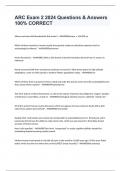
-
ARC Exam 2 2024 Questions & Answers 100% CORRECT
- Exam (elaborations) • 6 pages • 2024
-
Available in package deal
-
- $7.99
- + learn more
ARC Exam 2 2024 Questions & Answers 100% CORRECT Where and when did Neanderthals first evolve? - ANSWERSEurope, c. 400,000 ya Which of these hominins is known mostly from genetic evidence ratherthan extensive fossil or archaeological evidence? - ANSWERSDenisovans Homo floresiensis: - ANSWERSis likely a side branch of hominid evolution derived from H. erectus in Indonesia Newly recovered DNA from a Denisovan jawbone recovered in Tibet shows genes for high altitude adaptations, some ...
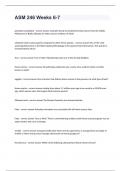
-
ASM 246 Arizona State University -ASM 246 Weeks 6-7 with complete solutions
- Exam (elaborations) • 5 pages • 2024
-
Available in package deal
-
- $11.49
- + learn more
ASM 246 Arizona State University -ASM 246 Weeks 6-7 with complete solutionspotential cannibalism - correct answer Cutmarks found on fossilized hominin bones from the middle Pleistocene of Bodo, Ethiopia are often used as evidence of what? relatively small cranial capacity compared to other Homo species. - correct answer One of the most surprising discoveries in the field of paleoanthropology is the species Homo floresiensis. This species is characterized by what? True - correct answer True...
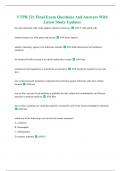
-
VTPB 221 Final Exam Questions And Answers With Latest Study Updates
- Exam (elaborations) • 25 pages • 2024
-
Available in package deal
-
- $13.99
- + learn more
VTPB 221 Final Exam Questions And Answers With Latest Study Updates the most important cells of the adaptive immune system are ANS T cells and B cells modern humans are what genus and species ANS homo sapiens adaptive immunity against viral infections includes ANS both humoral and cell mediated immunity the historical fertile crescent is in which modern-day country ANS Iraq commensal microorganisms or microbiota are present in ANS mouth gut respiratory tract and skin
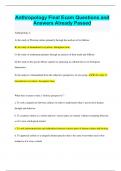
-
Anthropology Final Exam Questions and Answers Already Passed
- Exam (elaborations) • 197 pages • 2024
- Available in package deal
-
- $12.99
- + learn more
Anthropology Final Exam Questions and Answers Already Passed Anthropology is A) the study of Western culture primarily through the analysis of its folklore. B) the study of humankind everywhere, throughout time. C) the study of nonhuman primates through an analysis of their myth and folklore. D) the study of the species Homo sapiens by analyzing its cultural but not its biological dimensions. E) the analysis of humankind from the subjective perspective of one group. B) the study of...

-
ANTHROPOLOGY EXAM 3 WVU WITH CERTIFIED SOLUTIONS
- Exam (elaborations) • 20 pages • 2024
- Available in package deal
-
- $9.99
- + learn more
ANTHROPOLOGY EXAM 3 WVU WITH CERTIFIED SOLUTIONS what makes us human? Bipedalism, brains, skulls, Childhood dependency, tools, teeth biopedalism stresses the advantages it provided in a habitat increasingly dominated by dry, savanna-like conditions. Brains and skulls Early hominins had very small brains, Brain size has increased during hominin evolution, especially with the advent of the genus Homo. Childhood dependency Compared with the young of other primates, human children h...

Did you know that on average a seller on Stuvia earns $82 per month selling study resources? Hmm, hint, hint. Discover all about earning on Stuvia


